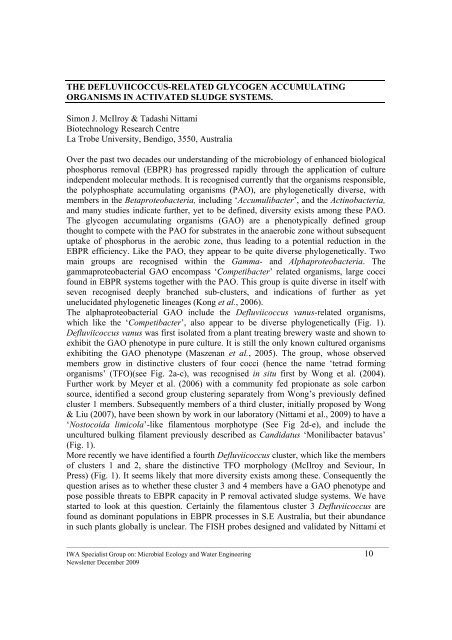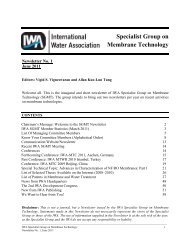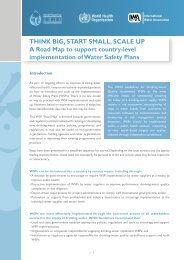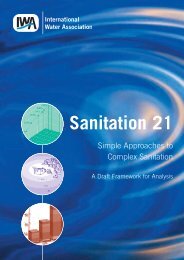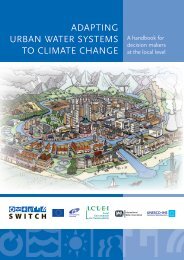Specialist Group on Microbial Ecology and Water Engineering - IWA
Specialist Group on Microbial Ecology and Water Engineering - IWA
Specialist Group on Microbial Ecology and Water Engineering - IWA
Create successful ePaper yourself
Turn your PDF publications into a flip-book with our unique Google optimized e-Paper software.
THE DEFLUVIICOCCUS-RELATED GLYCOGEN ACCUMULATINGORGANISMS IN ACTIVATED SLUDGE SYSTEMS.Sim<strong>on</strong> J. McIlroy & Tadashi NittamiBiotechnology Research CentreLa Trobe University, Bendigo, 3550, AustraliaOver the past two decades our underst<strong>and</strong>ing of the microbiology of enhanced biologicalphosphorus removal (EBPR) has progressed rapidly through the applicati<strong>on</strong> of cultureindependent molecular methods. It is recognised currently that the organisms resp<strong>on</strong>sible,the polyphosphate accumulating organisms (PAO), are phylogenetically diverse, withmembers in the Betaproteobacteria, including ‘Accumulibacter’, <strong>and</strong> the Actinobacteria,<strong>and</strong> many studies indicate further, yet to be defined, diversity exists am<strong>on</strong>g these PAO.The glycogen accumulating organisms (GAO) are a phenotypically defined groupthought to compete with the PAO for substrates in the anaerobic z<strong>on</strong>e without subsequentuptake of phosphorus in the aerobic z<strong>on</strong>e, thus leading to a potential reducti<strong>on</strong> in theEBPR efficiency. Like the PAO, they appear to be quite diverse phylogenetically. Twomain groups are recognised within the Gamma- <strong>and</strong> Alphaproteobacteria. Thegammaproteobacterial GAO encompass ‘Competibacter’ related organisms, large coccifound in EBPR systems together with the PAO. This group is quite diverse in itself withseven recognised deeply branched sub-clusters, <strong>and</strong> indicati<strong>on</strong>s of further as yetunelucidated phylogenetic lineages (K<strong>on</strong>g et al., 2006).The alphaproteobacterial GAO include the Defluviicoccus vanus-related organisms,which like the ‘Competibacter’, also appear to be diverse phylogenetically (Fig. 1).Defluviicoccus vanus was first isolated from a plant treating brewery waste <strong>and</strong> shown toexhibit the GAO phenotype in pure culture. It is still the <strong>on</strong>ly known cultured organismsexhibiting the GAO phenotype (Maszenan et al., 2005). The group, whose observedmembers grow in distinctive clusters of four cocci (hence the name ‘tetrad formingorganisms’ (TFO)(see Fig. 2a-c), was recognised in situ first by W<strong>on</strong>g et al. (2004).Further work by Meyer et al. (2006) with a community fed propi<strong>on</strong>ate as sole carb<strong>on</strong>source, identified a sec<strong>on</strong>d group clustering separately from W<strong>on</strong>g’s previously definedcluster 1 members. Subsequently members of a third cluster, initially proposed by W<strong>on</strong>g& Liu (2007), have been shown by work in our laboratory (Nittami et al., 2009) to have a‘Nostocoida limicola’-like filamentous morphotype (See Fig 2d-e), <strong>and</strong> include theuncultured bulking filament previously described as C<strong>and</strong>idatus ‘M<strong>on</strong>ilibacter batavus’(Fig. 1).More recently we have identified a fourth Defluviicoccus cluster, which like the membersof clusters 1 <strong>and</strong> 2, share the distinctive TFO morphology (McIlroy <strong>and</strong> Seviour, InPress) (Fig. 1). It seems likely that more diversity exists am<strong>on</strong>g these. C<strong>on</strong>sequently thequesti<strong>on</strong> arises as to whether these cluster 3 <strong>and</strong> 4 members have a GAO phenotype <strong>and</strong>pose possible threats to EBPR capacity in P removal activated sludge systems. We havestarted to look at this questi<strong>on</strong>. Certainly the filamentous cluster 3 Defluviicoccus arefound as dominant populati<strong>on</strong>s in EBPR processes in S.E Australia, but their abundancein such plants globally is unclear. The FISH probes designed <strong>and</strong> validated by Nittami et_________________________________________________________________________________________________<strong>IWA</strong> <str<strong>on</strong>g>Specialist</str<strong>on</strong>g> <str<strong>on</strong>g>Group</str<strong>on</strong>g> <strong>on</strong>: <strong>Microbial</strong> <strong>Ecology</strong> <strong>and</strong> <strong>Water</strong> <strong>Engineering</strong> 10Newsletter December 2009


